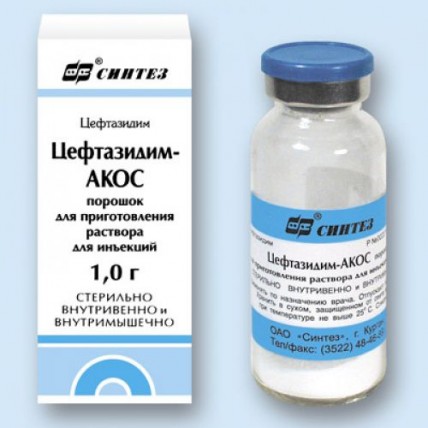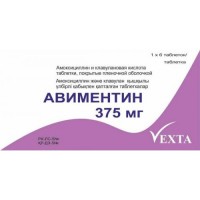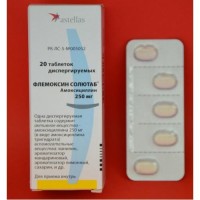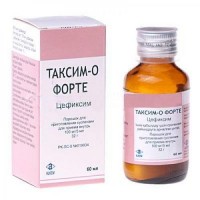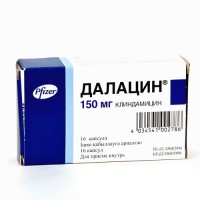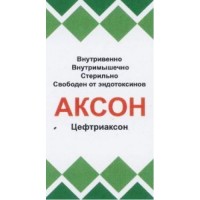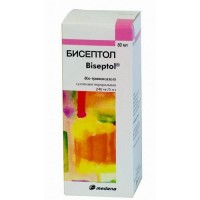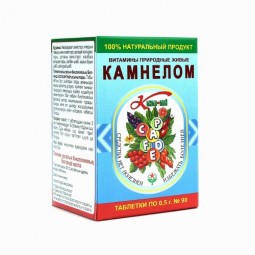Ceftazidime-Akos 1's 1g powder for solution for injection
- $4.00
The instruction
for medical use
of TSEFTAZIDIM-AKOS medicine
the Trade name
of TSEFTAZIDIM-AKOS
the International unlicensed
name Ceftazidime Dosage Form Powder for preparation of solution for injections of 1.0 g and 2.0 g
Structure on one bottle
active agent - a ceftazidime pentahydrate (in terms of a ceftazidime) 1.0 g or 2.0 g,
excipient - sodium a carbonate.
Description
powder, White or white with a yellowish or yellowish-brownish shade,
Pharmacotherapeutic group
Beta laktamnye antibacterial drugs other. Cephalosporins of the third generation.
The code of automatic telephone exchange J01DD02
the Pharmacological
Pharmacokinetics Maximum Concentration properties (Cmax) after intramuscular introduction (in oil) in a dose of 1 g - 39 mg/l, time necessary for achievement of the maximum concentration (TCmax) 1 of h Cmax after intravenous (in / c) bolyusny introduction in doses of 1 g and 2 g 69 mg/l and 170 mg/l respectively. Therapeutic effective serumal concentration remain in 8-12 h after intravenous and intramuscular administration. Communication with proteins of plasma not less than 10%. The concentration of a ceftazidime exceeding the minimum overwhelming concentration for the majority of widespread pathogenic microorganisms can be reached in a bone tissue, tissues of heart, bile, a phlegm, synovial fluid, intraocular, pleural and peritoneal liquids. The ceftazidime easily gets through a placental barrier, concentration of drug in the SMZh cerebrospinal fluid) low. In meningitis in cerebrospinal fluid the therapeutic concentration of a ceftazidime making 4-20 mg/l and above are reached.
The ceftazidime is not metabolized in an organism. Elimination half-life about 2 h, at newborns is 3-4 times more, than at adults.
The ceftazidime is removed in not changed look by kidneys by glomerular filtration. About 80-90% of a dose are allocated with kidneys during 24 h. Less than 1% of drug are removed with bile. In a renal failure the clearance rate of a ceftazidime decreases. At a hemodialysis the elimination half-life makes 3-5 h.
The pharmacodynamics
of Tseftazidim-AKOS is antibacterial drug from group of cephalosporins III of generation. Works bakteritsidno (breaks synthesis of a cell wall of microorganisms). Possesses a broad spectrum of activity. It is resistant to action of the majority beta laktamaz. Affects many strains resistant to ampicillin and other cephalosporins.
Drug is active concerning gram-negative microorganisms: Pseudomonas spp., including Pseudomonas aeruginosa, Klebsiella spp., including Klebsiella pneumoniae, Proteus mirabilis, Proteus vulgaris, Escherichia coli, Enterobacter spp., including Enterobacter aerogenes, Enterobacter cloacae, Citrobacter spp., including Citrobacter diversus, Citrobacter freundii, Pasteurella multocida, Neisseria meningitidis, Haemophillus influenzae (including the strains resistant to ampicillin),
gram-positive bacteria: Staphylococcus aureus (which are producing and not producing penicillinase the strains sensitive to Methicillinum), Streptococcus pyogenes (group A a beta and hemolytic streptococcus), Streptococcus agalactiae (group B), Streptococcus pneumoniae, anaerobic microorganisms: Bacterioides spp. (many strains of Bacterioides fragilis of a rezistentna).
Drug is inactive concerning resistant to Methicillinum Staphylococcus spp., Streptococcus faecalis, Enterococcus spp., Listeria monocytogenes, Campylobacter spp. and Clostridium difficile.
in vitro against the majority of strains of the following organisms is active (the clinical value of this activity is unknown): Clostridium perfingens, not including Clostridium difficile, Acinetobacter spp., Haemophilus parainfluenzae, Morganella morganii, Neisseria gonorrhoeae, Peptococcus spp., Peptostreptococcus spp., Providencia spp., Providencia rettgeri, Salmonella spp., Shigella spp., Staphylococcus epidermidis, Yersinia enterocolitica.
Indications
- heavy infections: meningitis, sepsis (septicaemia), heavy it is purulent - septic states
- infections of bones and joints: septic arthritis, osteomyelitis, a bacterial bursitis
- respiratory infections: acute and chronic bronchitis, the infected bronchietasia, the pneumonia caused by gram-negative bacteria, abscess of lungs, an empyema of a pleura, a lower respiratory tract infection at patients with cystous fibrosis
- infections of urinary tract: acute and chronic pyelonephritis, a pyelitis, prostatitis, cystitis, an urethritis (only bacterial), kidney abscess
- infections of skin and soft tissues: the mastitis, wound fevers, skin ulcers, phlegmon, an ugly face infected burns
- infections of digestive tract, an abdominal cavity and bilious ways: peritonitis, a coloenteritis, retroperitoneal abscess, a diverticulitis, cholecystitis, a cholangitis, an empyema of a gall bladder, an infection of bodies of a small pelvis
- an infection of an ear, a throat, a nose: average otitis, sinusitis, mastoiditis, etc.
Route of administration and doses
Intramusculary and intravenously. The dose of drug and a course of treatment are established individually, taking into account weight of a course of the disease, localization of an infection and sensitivity of the activator, age and body weight, function of kidneys.
For adults and children 12 years are more senior:
- in infections of urinary tract intramusculary or intravenously on 0.25 g-0.5 of each 12 h,
- in respiratory infections intramusculary or intravenously from 30 to 50 mg/kg/days, frequency rate of introduction - 3 times a day (use of a dose up to 9 g/days does not cause complications in such patients),
- in uncomplicated pneumonia, an infection of digestive tract, abdominal organs, infections of skin and soft tissues intramusculary or intravenously on 0,5 1,0 g each 8 h,
- in infections of bones and joints intravenously on 2 g each 12 h,
- in extremely heavy or zhizneugrozhayushchy infections (meningitis, sepsis (septicaemia), heavy it is purulent - septic states) intravenously on 2 g each 8 h.
The maximum daily dose should not exceed 6 g.
(Including patients to whom carry out dialysis), the dose decline can be required by adults with a renal failure after an initial load dose of 1 g, as shown below:
CLEARANCE of CREATININE
the DOSE
& gt, 50 ml/min. (0.83 ml / c)
you Watch the section For adults and children 12 years
35 - Are more senior than 50 ml/min. (0.52 - 0.83 ml / c)
On 1.0 g each 12 h
16 - 30 ml/min. (0.27 - 0.50 ml / c)
On 1.0 g each 24 h
6 - 15 ml/min. (0.10 - 0.25 ml / c)
On 0.5 g each 24 h
& lt, 5 ml/min. (/c)
On 0.5 g each 48 h
Patients to whom
patients to whom
each 24 h
At such patients carry out a peritoneal hemodialysis On 0.5 g carry out a hemodialysis On 1.0 g after each session of a hemodialysis Drug level in blood serum which should not exceed 40 mg/l is recommended to control 0.08 ml.
Elimination half-life of drug during a hemodialysis makes from 3rd to 5 hours. The corresponding dose of drug should be repeated after every period of dialysis. At peritoneal dialysis, drug can be included in dialysis liquid in a dose from 0.125 g to 0.250 g on 2 l of dialysis liquid.
Use for children up to 12 years:
- to newborns and babies up to 2 months intravenous infusion of 30 mg/kg a day (frequency rate 2 introductions),
- from 2 months to 12 years intravenous infusion of 30 - 50 mg/kg a day (frequency rate 3 introductions).
To children with reduced immunity, meningitis appoint a dose to 150 mg/kg/days (at most 6 g/days) each 12 hours intravenously or intramusculary.
Duration of therapy depends on a condition of the patient, nevertheless treatment needs to be continued after recovery of the patient within 48 hours.
Preparation of solutions
For introduction of 1.0 g in oil or 2.0 g tseftazidima-AKOS is dissolved in 3 ml of water for injections, for intravenous administration dissolved in 10 ml of water for injections.
For intravenous drop administration the drug solution received in the above way is in addition dissolved in 50-100 ml of one of the following solvents intended for intravenous administration:
- 0.9% chloride sodium solution.
- Ringera solution,
- 5%, 10% solution of glucose (dextrose),
- 5% solution of glucose (dextrose) from 0.9% solution of sodium of chloride,
-5% bicarbonate sodium solution.
At dissolution of powder, carbon dioxide is emitted. After administration of solvent the bottle needs to be stirred up that transparent solution turned out. At the received ready solution of drug there can be small vials of carbon dioxide.
The received solution can have color from light yellow to dark yellow. If all recommended rules of cultivation of drug are followed, then its efficiency does not depend on a shade.
To use only freshly cooked solution!
Side effects
Often
- nausea, vomiting
- a headache, dizziness
Infrequently
- makulo-papular rash, a small tortoiseshell, a fever or fever, rash, an itching
- a mycotic vulvovaginitis
- a meteorism, an abdominal pain, dysbacteriosis, an abnormal liver function, hole-
staz, orofaringealny candidiasis
- increase in activity of hepatic transaminases, LDG, GGT and alkaline
phosphatase
Seldom
- a bronchospasm, an eosinophilia, Stephens-Johnson's syndrome, toxic Epi -
a thermal necrolysis (Lyell's disease), a Quincke's disease, anafi-
laktichesky shock
- diarrhea or a constipation, stomatitis, a glossitis, pseudomembranous colitis
- a leukopenia, a neutropenia, a granulocytopenia, thrombocytopenia, a lymphocytosis,
hemolytic anemia, hypocoagulation
- jaundice
- a giperkreatininemiya, false positive forward reaction of Koombs, a giperba
a lirubinemiya, false positive reaction of urine to glucose, increase
in a prothrombin time
- a toxic nephropathy (an azotemia, increase in content of urea in kro-
vi), an oliguria, an anury
- paresthesias, a convulsive syndrome, encephalopathy, convulsions, a coma, porkha-
a yushchy tremor
- phlebitis (at intravenous administration), morbidity on the vein course, burning,
consolidation in the place of an injection (at intramuscular introduction)
Sometimes
- nasal bleedings,
Contraindication superinfection
- hypersensitivity to a ceftazidime, other components of drug and tsefalosporinovy antibiotics
Medicinal interactions
of Tseftazidim-AKOS pharmaceutical is incompatible with heparin, aminoglycosides (a considerable mutual inactivation: at simultaneous use these drugs should be administered in different parts of the body) and Vancomycinum (the deposit depending on concentration is formed, if necessary to administer two drugs through one tube, between their use the systems for intravenous administration should be washed out). It is impossible to use Natrii hydrocarbonas solution as solvent (dioxide is formed carbon, it can demand production of gas outside).
Loopback diuretics, aminoglycosides, Vancomycinum, clindamycin reduce clearance of a ceftazidime therefore the risk of nephrotoxic action increases.
Bacteriostatic antibiotics (including chloramphenicol) reduce effect of drug.
Pharmaceutical we will combine with the following solutions: at concentration from 1 to 40 mg/ml of sodium chloride of 0.9%, sodium a lactate, a dextrose of 5%, 10%.
At concentration from 0.05 to 0.25 mg/ml the ceftazidime is compatible to solution for intraperitoneal dialysis (lactate).
For introduction in oil tseftazidim-AKOS it can be divorced with solution of lidocaine of a hydrochloride of 0.5% or 1%. At ceftazidime solution mixing (500 mg in 1.5 ml of water for injections) and metronidazole (500 mg / 100 ml) both components keep the activity.
Special instructions
With care: a renal failure, the neonatality period, colitis in the anamnesis, a sprue (the risk of decrease in prothrombin activity, especially at persons with the profound renal and/or liver failure is increased).
The patients having allergic reactions to penicillin in the anamnesis can have hypersensitivity to tsefalosporinovy antibiotics.
Treatment tseftazidimom-AKOS needs to be interrupted, in case of emergence during treatment of heavy diarrhea and/or diarrhea with blood, colitis and pseudomembranous colitis and to appoint the corresponding treatment. Antiperistaltic drugs are forbidden.
Tseftazidim-AKOS appoint with care to patients with gastrointestinal disorders, especially colitis in the anamnesis.
During long-term treatment by a ceftazidime, it is recommended to control blood tests, renal/hepatic functions.
During treatment it is impossible to use ethanol.
Pregnancy and the period of a lactation
of Tseftazidim-AKOS should be applied with care in the first months of pregnancy (I trimester).
Tseftazidim-AKOS it is allocated with breast milk therefore it is necessary to be careful when prescribing drug of mother during breastfeeding.
The feature of influence of medicine on ability to run the vehicle or potentially dangerous mechanisms
during treatment should be careful at control of vehicles and the occupation other potentially dangerous types of activity demanding the increased concentration of attention and speed of psychomotor reactions because of risk of developing of dizziness.
Overdose
Symptoms: pain, inflammation, phlebitis in the place of an injection, dizziness, paresthesias, a headache, spasms at patients with a renal failure, a giperkreatininemiya, a hyperbilirubinemia, a thrombocytosis, thrombocytopenia, an eosinophilia, a leukopenia, lengthening of a prothrombin time.
Treatment: symptomatic, in case of a renal failure - peritoneal dialysis or a hemodialysis.
A form of release and packing
Powder for preparation of solution for injections.
On 1.0 g and 2.0 g of active agent in bottles with a capacity of 20 ml.
On 1 bottle with the instruction for medical use in the state and Russian languages place in a pack from cardboard.
To Store storage conditions in the dry, protected from light place, at
a temperature not higher than 25 Store OS out of children's reach!
3 years
not to use a period of storage after an expiration date.
Prescription status
According to the prescription
JSC Sintez Producer.
Russia, 640008, Kurgan, Konstitutsii Avenue, 7.
ph./fax (3522) 48-16-89
The owner of the registration certificate
of JSC Sintez, Russia
To develop
for medical use
of TSEFTAZIDIM-AKOS medicine
the Trade name
of TSEFTAZIDIM-AKOS
the International unlicensed
name Ceftazidime Dosage Form Powder for preparation of solution for injections of 1.0 g and 2.0 g
Structure on one bottle
active agent - a ceftazidime pentahydrate (in terms of a ceftazidime) 1.0 g or 2.0 g,
excipient - sodium a carbonate.
Description
powder, White or white with a yellowish or yellowish-brownish shade,
Pharmacotherapeutic group
Beta laktamnye antibacterial drugs other. Cephalosporins of the third generation.
The code of automatic telephone exchange J01DD02
the Pharmacological
Pharmacokinetics Maximum Concentration properties (Cmax) after intramuscular introduction (in oil) in a dose of 1 g - 39 mg/l, time necessary for achievement of the maximum concentration (TCmax) 1 of h Cmax after intravenous (in / c) bolyusny introduction in doses of 1 g and 2 g 69 mg/l and 170 mg/l respectively. Therapeutic effective serumal concentration remain in 8-12 h after intravenous and intramuscular administration. Communication with proteins of plasma not less than 10%. The concentration of a ceftazidime exceeding the minimum overwhelming concentration for the majority of widespread pathogenic microorganisms can be reached in a bone tissue, tissues of heart, bile, a phlegm, synovial fluid, intraocular, pleural and peritoneal liquids. The ceftazidime easily gets through a placental barrier, concentration of drug in the SMZh cerebrospinal fluid) low. In meningitis in cerebrospinal fluid the therapeutic concentration of a ceftazidime making 4-20 mg/l and above are reached.
The ceftazidime is not metabolized in an organism. Elimination half-life about 2 h, at newborns is 3-4 times more, than at adults.
The ceftazidime is removed in not changed look by kidneys by glomerular filtration. About 80-90% of a dose are allocated with kidneys during 24 h. Less than 1% of drug are removed with bile. In a renal failure the clearance rate of a ceftazidime decreases. At a hemodialysis the elimination half-life makes 3-5 h.
The pharmacodynamics
of Tseftazidim-AKOS is antibacterial drug from group of cephalosporins III of generation. Works bakteritsidno (breaks synthesis of a cell wall of microorganisms). Possesses a broad spectrum of activity. It is resistant to action of the majority beta laktamaz. Affects many strains resistant to ampicillin and other cephalosporins.
Drug is active concerning gram-negative microorganisms: Pseudomonas spp., including Pseudomonas aeruginosa, Klebsiella spp., including Klebsiella pneumoniae, Proteus mirabilis, Proteus vulgaris, Escherichia coli, Enterobacter spp., including Enterobacter aerogenes, Enterobacter cloacae, Citrobacter spp., including Citrobacter diversus, Citrobacter freundii, Pasteurella multocida, Neisseria meningitidis, Haemophillus influenzae (including the strains resistant to ampicillin),
gram-positive bacteria: Staphylococcus aureus (which are producing and not producing penicillinase the strains sensitive to Methicillinum), Streptococcus pyogenes (group A a beta and hemolytic streptococcus), Streptococcus agalactiae (group B), Streptococcus pneumoniae, anaerobic microorganisms: Bacterioides spp. (many strains of Bacterioides fragilis of a rezistentna).
Drug is inactive concerning resistant to Methicillinum Staphylococcus spp., Streptococcus faecalis, Enterococcus spp., Listeria monocytogenes, Campylobacter spp. and Clostridium difficile.
in vitro against the majority of strains of the following organisms is active (the clinical value of this activity is unknown): Clostridium perfingens, not including Clostridium difficile, Acinetobacter spp., Haemophilus parainfluenzae, Morganella morganii, Neisseria gonorrhoeae, Peptococcus spp., Peptostreptococcus spp., Providencia spp., Providencia rettgeri, Salmonella spp., Shigella spp., Staphylococcus epidermidis, Yersinia enterocolitica.
Indications
- heavy infections: meningitis, sepsis (septicaemia), heavy it is purulent - septic states
- infections of bones and joints: septic arthritis, osteomyelitis, a bacterial bursitis
- respiratory infections: acute and chronic bronchitis, the infected bronchietasia, the pneumonia caused by gram-negative bacteria, abscess of lungs, an empyema of a pleura, a lower respiratory tract infection at patients with cystous fibrosis
- infections of urinary tract: acute and chronic pyelonephritis, a pyelitis, prostatitis, cystitis, an urethritis (only bacterial), kidney abscess
- infections of skin and soft tissues: the mastitis, wound fevers, skin ulcers, phlegmon, an ugly face infected burns
- infections of digestive tract, an abdominal cavity and bilious ways: peritonitis, a coloenteritis, retroperitoneal abscess, a diverticulitis, cholecystitis, a cholangitis, an empyema of a gall bladder, an infection of bodies of a small pelvis
- an infection of an ear, a throat, a nose: average otitis, sinusitis, mastoiditis, etc.
Route of administration and doses
Intramusculary and intravenously. The dose of drug and a course of treatment are established individually, taking into account weight of a course of the disease, localization of an infection and sensitivity of the activator, age and body weight, function of kidneys.
For adults and children 12 years are more senior:
- in infections of urinary tract intramusculary or intravenously on 0.25 g-0.5 of each 12 h,
- in respiratory infections intramusculary or intravenously from 30 to 50 mg/kg/days, frequency rate of introduction - 3 times a day (use of a dose up to 9 g/days does not cause complications in such patients),
- in uncomplicated pneumonia, an infection of digestive tract, abdominal organs, infections of skin and soft tissues intramusculary or intravenously on 0,5 1,0 g each 8 h,
- in infections of bones and joints intravenously on 2 g each 12 h,
- in extremely heavy or zhizneugrozhayushchy infections (meningitis, sepsis (septicaemia), heavy it is purulent - septic states) intravenously on 2 g each 8 h.
The maximum daily dose should not exceed 6 g.
(Including patients to whom carry out dialysis), the dose decline can be required by adults with a renal failure after an initial load dose of 1 g, as shown below:
CLEARANCE of CREATININE
the DOSE
& gt, 50 ml/min. (0.83 ml / c)
you Watch the section For adults and children 12 years
35 - Are more senior than 50 ml/min. (0.52 - 0.83 ml / c)
On 1.0 g each 12 h
16 - 30 ml/min. (0.27 - 0.50 ml / c)
On 1.0 g each 24 h
6 - 15 ml/min. (0.10 - 0.25 ml / c)
On 0.5 g each 24 h
& lt, 5 ml/min. (/c)
On 0.5 g each 48 h
Patients to whom
patients to whom
each 24 h
At such patients carry out a peritoneal hemodialysis On 0.5 g carry out a hemodialysis On 1.0 g after each session of a hemodialysis Drug level in blood serum which should not exceed 40 mg/l is recommended to control 0.08 ml.
Elimination half-life of drug during a hemodialysis makes from 3rd to 5 hours. The corresponding dose of drug should be repeated after every period of dialysis. At peritoneal dialysis, drug can be included in dialysis liquid in a dose from 0.125 g to 0.250 g on 2 l of dialysis liquid.
Use for children up to 12 years:
- to newborns and babies up to 2 months intravenous infusion of 30 mg/kg a day (frequency rate 2 introductions),
- from 2 months to 12 years intravenous infusion of 30 - 50 mg/kg a day (frequency rate 3 introductions).
To children with reduced immunity, meningitis appoint a dose to 150 mg/kg/days (at most 6 g/days) each 12 hours intravenously or intramusculary.
Duration of therapy depends on a condition of the patient, nevertheless treatment needs to be continued after recovery of the patient within 48 hours.
Preparation of solutions
For introduction of 1.0 g in oil or 2.0 g tseftazidima-AKOS is dissolved in 3 ml of water for injections, for intravenous administration dissolved in 10 ml of water for injections.
For intravenous drop administration the drug solution received in the above way is in addition dissolved in 50-100 ml of one of the following solvents intended for intravenous administration:
- 0.9% chloride sodium solution.
- Ringera solution,
- 5%, 10% solution of glucose (dextrose),
- 5% solution of glucose (dextrose) from 0.9% solution of sodium of chloride,
-5% bicarbonate sodium solution.
At dissolution of powder, carbon dioxide is emitted. After administration of solvent the bottle needs to be stirred up that transparent solution turned out. At the received ready solution of drug there can be small vials of carbon dioxide.
The received solution can have color from light yellow to dark yellow. If all recommended rules of cultivation of drug are followed, then its efficiency does not depend on a shade.
To use only freshly cooked solution!
Side effects
Often
- nausea, vomiting
- a headache, dizziness
Infrequently
- makulo-papular rash, a small tortoiseshell, a fever or fever, rash, an itching
- a mycotic vulvovaginitis
- a meteorism, an abdominal pain, dysbacteriosis, an abnormal liver function, hole-
staz, orofaringealny candidiasis
- increase in activity of hepatic transaminases, LDG, GGT and alkaline
phosphatase
Seldom
- a bronchospasm, an eosinophilia, Stephens-Johnson's syndrome, toxic Epi -
a thermal necrolysis (Lyell's disease), a Quincke's disease, anafi-
laktichesky shock
- diarrhea or a constipation, stomatitis, a glossitis, pseudomembranous colitis
- a leukopenia, a neutropenia, a granulocytopenia, thrombocytopenia, a lymphocytosis,
hemolytic anemia, hypocoagulation
- jaundice
- a giperkreatininemiya, false positive forward reaction of Koombs, a giperba
a lirubinemiya, false positive reaction of urine to glucose, increase
in a prothrombin time
- a toxic nephropathy (an azotemia, increase in content of urea in kro-
vi), an oliguria, an anury
- paresthesias, a convulsive syndrome, encephalopathy, convulsions, a coma, porkha-
a yushchy tremor
- phlebitis (at intravenous administration), morbidity on the vein course, burning,
consolidation in the place of an injection (at intramuscular introduction)
Sometimes
- nasal bleedings,
Contraindication superinfection
- hypersensitivity to a ceftazidime, other components of drug and tsefalosporinovy antibiotics
Medicinal interactions
of Tseftazidim-AKOS pharmaceutical is incompatible with heparin, aminoglycosides (a considerable mutual inactivation: at simultaneous use these drugs should be administered in different parts of the body) and Vancomycinum (the deposit depending on concentration is formed, if necessary to administer two drugs through one tube, between their use the systems for intravenous administration should be washed out). It is impossible to use Natrii hydrocarbonas solution as solvent (dioxide is formed carbon, it can demand production of gas outside).
Loopback diuretics, aminoglycosides, Vancomycinum, clindamycin reduce clearance of a ceftazidime therefore the risk of nephrotoxic action increases.
Bacteriostatic antibiotics (including chloramphenicol) reduce effect of drug.
Pharmaceutical we will combine with the following solutions: at concentration from 1 to 40 mg/ml of sodium chloride of 0.9%, sodium a lactate, a dextrose of 5%, 10%.
At concentration from 0.05 to 0.25 mg/ml the ceftazidime is compatible to solution for intraperitoneal dialysis (lactate).
For introduction in oil tseftazidim-AKOS it can be divorced with solution of lidocaine of a hydrochloride of 0.5% or 1%. At ceftazidime solution mixing (500 mg in 1.5 ml of water for injections) and metronidazole (500 mg / 100 ml) both components keep the activity.
Special instructions
With care: a renal failure, the neonatality period, colitis in the anamnesis, a sprue (the risk of decrease in prothrombin activity, especially at persons with the profound renal and/or liver failure is increased).
The patients having allergic reactions to penicillin in the anamnesis can have hypersensitivity to tsefalosporinovy antibiotics.
Treatment tseftazidimom-AKOS needs to be interrupted, in case of emergence during treatment of heavy diarrhea and/or diarrhea with blood, colitis and pseudomembranous colitis and to appoint the corresponding treatment. Antiperistaltic drugs are forbidden.
Tseftazidim-AKOS appoint with care to patients with gastrointestinal disorders, especially colitis in the anamnesis.
During long-term treatment by a ceftazidime, it is recommended to control blood tests, renal/hepatic functions.
During treatment it is impossible to use ethanol.
Pregnancy and the period of a lactation
of Tseftazidim-AKOS should be applied with care in the first months of pregnancy (I trimester).
Tseftazidim-AKOS it is allocated with breast milk therefore it is necessary to be careful when prescribing drug of mother during breastfeeding.
The feature of influence of medicine on ability to run the vehicle or potentially dangerous mechanisms
during treatment should be careful at control of vehicles and the occupation other potentially dangerous types of activity demanding the increased concentration of attention and speed of psychomotor reactions because of risk of developing of dizziness.
Overdose
Symptoms: pain, inflammation, phlebitis in the place of an injection, dizziness, paresthesias, a headache, spasms at patients with a renal failure, a giperkreatininemiya, a hyperbilirubinemia, a thrombocytosis, thrombocytopenia, an eosinophilia, a leukopenia, lengthening of a prothrombin time.
Treatment: symptomatic, in case of a renal failure - peritoneal dialysis or a hemodialysis.
A form of release and packing
Powder for preparation of solution for injections.
On 1.0 g and 2.0 g of active agent in bottles with a capacity of 20 ml.
On 1 bottle with the instruction for medical use in the state and Russian languages place in a pack from cardboard.
To Store storage conditions in the dry, protected from light place, at
a temperature not higher than 25 Store OS out of children's reach!
3 years
not to use a period of storage after an expiration date.
Prescription status
According to the prescription
JSC Sintez Producer.
Russia, 640008, Kurgan, Konstitutsii Avenue, 7.
ph./fax (3522) 48-16-89
The owner of the registration certificate
of JSC Sintez, Russia
To develop
